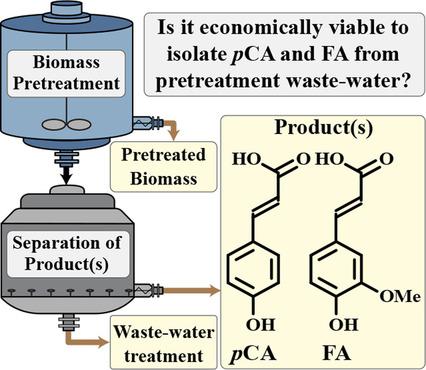当前位置:
X-MOL 学术
›
ChemSusChem
›
论文详情
Our official English website, www.x-mol.net, welcomes your
feedback! (Note: you will need to create a separate account there.)
Assessing the Viability of Recovery of Hydroxycinnamic Acids from Lignocellulosic Biorefinery Alkaline Pretreatment Waste Streams.
ChemSusChem ( IF 7.5 ) Pub Date : 2020-03-11 , DOI: 10.1002/cssc.201903345 Steven D Karlen 1, 2 , Peyman Fasahati 1, 3 , Mona Mazaheri 1, 4 , Jose Serate 1 , Rebecca A Smith 1, 2 , Sirisha Sirobhushanam 5 , Mingjie Chen 1, 6 , Vitaliy I Tymokhin 1 , Cynthia L Cass 5 , Sarah Liu 1, 2 , Dharshana Padmakshan 1, 2 , Dan Xie 1 , Yaoping Zhang 1 , Mick A McGee 1 , Jason D Russell 1, 7 , Joshua J Coon 1, 7, 8, 9 , Heidi F Kaeppler 1, 4 , Natalia de Leon 1, 4 , Christos T Maravelias 1, 3 , Troy M Runge 6 , Shawn M Kaeppler 1, 4 , John C Sedbrook 5 , John Ralph 1, 2
ChemSusChem ( IF 7.5 ) Pub Date : 2020-03-11 , DOI: 10.1002/cssc.201903345 Steven D Karlen 1, 2 , Peyman Fasahati 1, 3 , Mona Mazaheri 1, 4 , Jose Serate 1 , Rebecca A Smith 1, 2 , Sirisha Sirobhushanam 5 , Mingjie Chen 1, 6 , Vitaliy I Tymokhin 1 , Cynthia L Cass 5 , Sarah Liu 1, 2 , Dharshana Padmakshan 1, 2 , Dan Xie 1 , Yaoping Zhang 1 , Mick A McGee 1 , Jason D Russell 1, 7 , Joshua J Coon 1, 7, 8, 9 , Heidi F Kaeppler 1, 4 , Natalia de Leon 1, 4 , Christos T Maravelias 1, 3 , Troy M Runge 6 , Shawn M Kaeppler 1, 4 , John C Sedbrook 5 , John Ralph 1, 2
Affiliation

|
The hydroxycinnamic acids p-coumaric acid (pCA) and ferulic acid (FA) add diversity to the portfolio of products produced by using grass-fed lignocellulosic biorefineries. The level of lignin-bound pCA in Zea mays was modified by the alteration of p-coumaroyl-CoA monolignol transferase expression. The biomass was processed in a lab-scale alkaline-pretreatment biorefinery process and the data were used for a baseline technoeconomic analysis to determine where to direct future research efforts to couple plant design to biomass utilization processes. It is concluded that future plant engineering efforts should focus on strategies that ramp up accumulation of one type of hydroxycinnamate (pCA or FA) predominantly and suppress that of the other. Technoeconomic analysis indicates that target extraction titers of one hydroxycinnamic acid need to be >50 g kg-1 biomass, at least five times higher than observed titers for the impure pCA/FA product mixture from wild-type maize. The technical challenge for process engineers is to develop a viable process that requires more than 80 % reduction of the isolation costs.
中文翻译:

评估从木质纤维素生物精炼厂碱性预处理废物流中回收羟基肉桂酸的可行性。
羟基肉桂酸对香豆酸 (pCA) 和阿魏酸 (FA) 为草饲木质纤维素生物精炼厂生产的产品组合增添了多样性。玉米中木质素结合的 pCA 水平通过改变对香豆酰基辅酶 A 单一木质素转移酶表达而改变。生物质在实验室规模的碱预处理生物精炼过程中进行处理,数据用于基线技术经济分析,以确定未来的研究工作方向,将工厂设计与生物质利用过程结合起来。结论是,未来的植物工程工作应侧重于主要增加一种羟基肉桂酸酯(pCA 或 FA)积累并抑制另一种羟基肉桂酸酯积累的策略。技术经济分析表明,一种羟基肉桂酸的目标提取滴度需要为 >50 g kg-1 生物量,比野生型玉米中不纯的 pCA/FA 产品混合物观察到的滴度至少高五倍。工艺工程师面临的技术挑战是开发一种可行的工艺,需要将隔离成本降低 80% 以上。
更新日期:2020-04-22
中文翻译:

评估从木质纤维素生物精炼厂碱性预处理废物流中回收羟基肉桂酸的可行性。
羟基肉桂酸对香豆酸 (pCA) 和阿魏酸 (FA) 为草饲木质纤维素生物精炼厂生产的产品组合增添了多样性。玉米中木质素结合的 pCA 水平通过改变对香豆酰基辅酶 A 单一木质素转移酶表达而改变。生物质在实验室规模的碱预处理生物精炼过程中进行处理,数据用于基线技术经济分析,以确定未来的研究工作方向,将工厂设计与生物质利用过程结合起来。结论是,未来的植物工程工作应侧重于主要增加一种羟基肉桂酸酯(pCA 或 FA)积累并抑制另一种羟基肉桂酸酯积累的策略。技术经济分析表明,一种羟基肉桂酸的目标提取滴度需要为 >50 g kg-1 生物量,比野生型玉米中不纯的 pCA/FA 产品混合物观察到的滴度至少高五倍。工艺工程师面临的技术挑战是开发一种可行的工艺,需要将隔离成本降低 80% 以上。











































 京公网安备 11010802027423号
京公网安备 11010802027423号